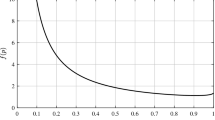Abstract
We consider the estimation of arrival and service rates for queues based on queue length data collected at successive, not necessarily equally spaced, time points. In particular, we consider the M/M/c queue, for c large, but application of the method to the repairman problem is almost identical, and the general approach presented should extend to other queue types. The estimation procedure makes use of an Ornstein-Uhlenbeck diffusion approximation to the Markov process description of the queue. We demonstrate the approach through simulation studies and discuss situations in which the approximation works best.
Similar content being viewed by others
References
S.K. Acharya, On normal approximation for maximum likelihood estimation from single server queues. Queueing Systems 31 (1999) 207–216.
C. Armero, Bayesian inference in Markovian queues. Queueing Systems 15 (1994) 419–426.
C. Armero and M.J. Bayarri, Bayesian prediction in M/M/1 queues. Queueing Systems 15 (1994) 401–417.
A.D. Barbour, On a functional central limit theorem for Markov population processes. Adv. Appl. Probab. 6 (1974) 21–39.
A.D. Barbour, Quasi-stationary distributions in Markov population processes. Adv. Appl. Probab. 8 (1976) 296–314.
A.D. Barbour, Equilibrium distributions Markov population processes. Adv. Appl. Probab. 12 (1980) 591–614.
A.D. Barbour, Density-dependent Markov population processes. In W. Jäger, H. Rost and P. Tautu (eds.), Biological growth and spread Lecture Notes in Biomathematics (Springer, Berlin, 1980) vol. 38, pp. 36–49.
I.V. Basawa and N.U. Prabhu, Large sample inference from single server queues. Queueing Systems 3 (1988) 289–304.
I.V. Basawa, U.N. Bhat, and R. Lund, Maximum likelihood estimation for single server queues from waiting time data. Queueing Systems 24 (1997) 155–167.
U.N. Bhat and S.S. Rao, Statistical analysis of queueing systems. Queueing Systems 1 (1987) 217–247.
N.H. Bingham and S.M. Pitts, Non-parametric estimation for the M/G/∞ queue. Ann. Inst. Statist. Math. 1 (1999) 71–97.
A.B. Clarke, Maximum likelihood estimates in a simple queue. Ann. Math. Statist. 28 (1957) 1036–1040.
P.D. Feigin, Maximum likelihood estimation for continuous-time stochastic processes. Adv. Appl. Probab. 8 (1976) 712–736.
D.L. Iglehart, Limiting diffusion approximations for the many server queue and the repairman problem. J. Appl. Probab. 2 (1965) 429–441.
T. Kurtz, Solutions of ordinary differential equations as limits of pure jump Markov processes. J. Appl. Probab. 7 (1970) 49–58.
T. Kurtz, Limit theorems for sequences of jump Markov processes approximating ordinary differential processes. J. Appl. Probab. 8 (1971) 344–356.
D.R. McNeil and G.H. Weiss, A large population approach to estimation of parameters in Markov population models. Biometrika 64 (1977) 553–558.
P.K. Pollett, On a model for interference between searching insect parasites. J. Austral. Math. Soc. Ser. B 32 (1990) 133–150.
J.V. Ross, T. Taimre, and P.K. Pollett, On parameter estimation in population models. Theor. Popul. Biol. 70 (2006) 498–510.
R.Y. Rubinstein and D.P. Kroese, The Cross-Entropy Method: A Unified Approach to Combinatorial Optimization, Monte-Carlo Simulation, and Machine Learning (Springer-Verlag, New York, 2004).
G.B. Rybicki, Unpublished Notes: Notes on gaussian random functions with exponential correlation functions (Ornstein-Uhlenbeck Process) from http://www.lanl.gov/DLDSTP/fast/. (1994).
G.B. Rybicki and W.H. Press, A class of fast methods for processing irregularly sampled or otherwise inhomogeneous one-dimensional data. Phys. Rev. Lett. 74 (1995) 1060–1063.
A.R. Ward and P.W. Glynn, A diffusion approximation for a Markovian queue with reneging. Queueing Systems 43 (2003) 103–128.
A.R. Ward and P.W. Glynn, Properties of the reflected Ornstein-Uhlenbeck process. Queueing Systems 44 (2003) 109–123.
A.R. Ward and P.W. Glynn, A diffusion approximation for a GI/GI/1 queue with balking or reneging. Queueing Systems 50 (2005) 371–400.
R.W. Wolff, Problems of statistical inference for birth and death queueing models. Operat. Res. 13 (1965) 343–357.
Author information
Authors and Affiliations
Corresponding author
Additional information
AMS Subject Classifications 60J20, 60J60, 60K25, 62M05, 62F10
Rights and permissions
About this article
Cite this article
Ross, J.V., Taimre, T. & Pollett, P.K. Estimation for queues from queue length data. Queueing Syst 55, 131–138 (2007). https://doi.org/10.1007/s11134-006-9009-2
Received:
Revised:
Published:
Issue Date:
DOI: https://doi.org/10.1007/s11134-006-9009-2



